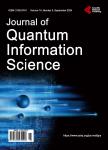Undulatory Theory with Paraconsistent Logic (Part I): Quantum Logical Model with Two Wave Functions
Undulatory Theory with Paraconsistent Logic (Part I): Quantum Logical Model with Two Wave Functions作者机构:Laboratory of Applied Paraconsistent Logic Santa Cecilia University Santos Brazil
出 版 物:《Journal of Quantum Information Science》 (量子信息科学期刊(英文))
年 卷 期:2016年第6卷第3期
页 面:143-180页
学科分类:07[理学] 070201[理学-理论物理] 0702[理学-物理学]
主 题:Paraconsistent Logic Quantum Mechanics Paraquantum Logic Undulatory Theory Quantum Model
摘 要:Paraconsistent logic (PL) is a non-classical logic that accepts contradiction in its foundations. It can be represented in the form of paraconsistent annotated logic with annotation of two values (PAL2v). When used to model quantum phenomena, PAL2v is called paraquantum logic (PQL). In this work, the concept of PQL is applied to create a logical model presenting the fundamental principles of quantum mechanics that support particle-wave theory. This study uses the well-known Young’s double-slit experiment, wherein quantum phenomena appear when a monochromatic light beam passes through the two slits. We focused on a reference point located between the slits, where we observed the effects of two types of wave interferences in a region defined as a two-wave region (2W region). Considering that the effect in this 2W region is very similar to that studied by Huygens, we adopt a paraquantum logical model in which a particle (or quantum) is represented by two wave functions. The two wave functions result in four State Vectors (Ket, Bra,,) in the PQL Lattice that express the symmetry and the entanglement of Quantum Mechanics. The constructed model adapts well to the quantum phenomena, is strongly consistent, and can be considered as an innovative form of analysis in the field of quantum mechanics. Based on this model, we present in two parts (Part I and Part II) the comparative analysis of values found in SchrÖdinger’s equation and probabilistic models of wave-particle theory using Bonferroni inequality.



